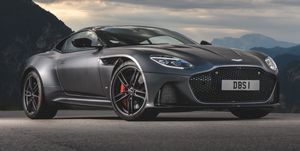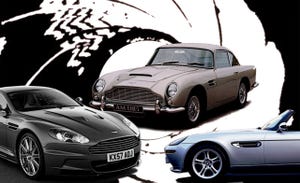From the May 1991 issue of Car and Driver.
It’s been all quiet on the Aston front since Sean Connery signed off as 007 and quit playing fast and loose with British bodies made of hand-swagged aluminum (and other bodies made of softer material). We’ve spent these years waiting for the lads at Newport Pagnell to pound out some new work we’d call lustworthy. Something to boil the old blood a bit.
Something like this Virage.
Aston Martin aims its new Virage at patrons of aesthetic restraint whose budgets know no restraint. Fork over $24,000 to cover the luxury and gas-guzzler taxes, on top of the price of the car itself, and you will thunder home nearly a quarter-million dollars poorer. Or a quarter-million less rich, depending on your perspective.
Ferrari fanatics will dismiss the Aston as a glorified Mustang in killer paint. But before Aston Martin stands wrongly accused, let us say that the Virage comes fresh to market after an accelerated four-year development that brings with it big advances. Peek under its aluminum attire and you’ll find—for the first time in two decades—an Aston fresh in shape, chassis, engine, and interior. The company chose all this from five competing designs. The winner, by John Heffernan and Ken Greenley, underwent computer studies that led to full-scale drawings and a 1:1 mahogany replica honed to pluperfect shape from which the tooling proceeded.
For power, the Brits raided America. They turned Reeves “Corvette” Callaway into a Connecticut Yankee in Queen Aston’s court. Known for boosting the outputs of Chevy’s plastic playthings to power approximating that of plastique, Callaway crafted twin-cam, four-valve-per-cylinder heads for Aston’s 5.3- liter aluminum V-8 engine. Fitted with Weber-Marelli electronic management and port fuel injection, the grand dame wound up the dyno to 325 horsepower at 6000 rpm. Which we set out to sample for ourselves, an act made possible by Rick Mancuso, a Chicago dealer in Astons and other unobtainables, who loaned us the Virage with but one caveat: don’t put any more than 400 miles on the odometer.
The car’s bodywork, more inspiring in detail than in sum, highlights brilliant handiwork and paintwork. The blunt yet rounded breastworks lead the way to a decent Cd of 0.34. The lights see well down the road at night and look slick during the day. The side windows, less smoothly integrated, lead your gaze to dual fuel-filler flaps below the C-pillars. An interconnection allows you to add super unleaded to the huge 29.9-gallon tank from either flank.
The V-8 looks almighty, but Aston pits it against the car’s all mighty mass, a crushing 4349 pounds. But despite the car’s size, Aston didn’t interrupt the space between engine and fuel tank with much of a cabin. Despite the potential offered by the Virage’s 186.8-inch overall length, 102.8-inch wheelbase, and 52.0-inch height, none of us fit well. We couldn’t find a compromise that included a handy reach to the distant wheel, kneeroom unencumbered by the low dash, and a full view of both the tachometer and speedometer. Too bad, because the front seats hold up their end—and yours—in fine style. The rear “seats,” however, feel like baby benches sunk into a wishing well, making us wish for more romper room. Even petite women find that extracting themselves from the rear requires a stump puller, total immodesty, and the Corps of Engineers. We can’t call the Virage a two-plus-two—it’s more like a two-plus-two half-pints. But the leather, stitching, padding, and wood show high quality. A suede headliner compels people to touch it. Connolly-leather seats and black piping offset burl-walnut trim. Faults include a slab-like dash layout that stacks massive façades of leather, plastic, and wood; lumpy screws that secure the fuse-panel; and visors that loom too low.
A classy toolkit and a spacesaver spare wedge into a trunk well behind the rear seat. The kit includes white gloves with suede palms should an owner be faced with changing one of the enormous Avons. The trunk lid looks stubby for good reason: it conceals a small trunk. Though a five-speed gearbox is standard, our mount was saddled with the optional three-speed automatic, its shifter jutting from the console. The five-speed promised better performance but the three-speed automatic was all that Mancuso could supply. Grappling with the weight, the automatic shuffles the Aston off the mark at full throttle, provides lethargic shift response, and revs up one gear shy of efficiency. Downshifts must often be forced manually because the transmission has a tendency to upshift early and suffers a reluctance to be prodded to life with the toe alone.
Given the automatic Aston’s 145-mph top speed, one-fourth of the 200-mph speedometer remains unswept (though the five-speed gearbox adds about 10 mph). The rest of the instrumentation reads more logically. Within the upper arc of the steering wheel, the layout composes everything you most want to know about the car’s running and gunning characteristics. A slim trip computer occupies the mid-dash area. Small, faintly labeled buttons control ten small, faintly lit readouts. If you can read them in daylight or find the right buttons at night, you possess the eyes of a young Stirling Moss (which he’d like returned along with his hair). Beneath the computer, an ugly row of big buttons controls more important functions. The British old-boy network bagged Aston a fine-working Jaguar climate-control system. (You might attribute that to Ford taking a controlling interest in each company, but Aston benefited sooner because Ford bought it three years sooner—in 1987—only a year after Aston’s Virage development began.) Alas, a Blaupunkt AM/FM/compact-disc player has not been positioned within easy reach. It wears aristocratic mustard-yellow markings that don’t match the white markings that lend clarity to the rest of the cabin layout; the clarity of the stereo, however, isn’t bad.
Despite its recent birth, the Virage presents a pretty archaic picture. Even on eight-inch-wide alloy rims, its tall Avon Turbospeed 255/60ZR-16 tires look old-timey compared with now-common low-profile rubber. Still, the Avons achieve 0.80-g roadholding on the skidpad. On the road they make good use of the geometry and damping of the suspension—front: control arms, coil springs, and anti-roll bar; rear: a de Dion rigid axle located by a Watts linkage and diagonal trailing arms, plus coil springs and an anti-roll bar. Over big bumps the Virage grows thunky, but it feels well controlled for such a heavyweight. It gets blown around by the wind, yet freed of this invisible buffeting, the big Aston motors along with substantive assurance.
Aston’s sizable disc brakes, vented in front, lack ABS. They produce only 200-foot stops, less than wonderful for a monster that runs 0 to 60 in 7.4 seconds. The five-speed gearbox should reduce that by about a half-second. Hard runs can send the fuel economy lower than the EPA city cycle’s 11 mpg and our own 10 mpg overall.
Things that went wonky: the hood release sometimes didn’t; the trunk release conked completely; the motor on the passenger’s passive harness motored intermittently; the passenger’s power-seat switch sometimes switched off; and, after a few passes for photography, the powertrain began surging, and the fuel pump emitted an unearthly caterwauling. A quieter failure: a loose boot between the turn-signal/cruise-control lever and the steering column. A bad sign: an exhaust system whose hammered and dented pieces hang very low, suggesting a ball-peen mentality at the factory regarding worldwide emissions requirements.
In some ways, Aston means great quality. In others, abysmal blacksmithing.
Disbelievers will call the Virage your $241,500 glorified Mustang. Worse, drivers of truly quick cars will pick on it. This kind of money should get you a car that tears free of the herd like instinct unbridled. It should make you feel as if you’re clinging—barely, by its mane—to a wild horse plunging and hurdling through a thunderstorm. Instead you may come away feeling as if you’ve plinked your quarter (of a million) into the slot for a ride on an overweight hobbyhorse that’s been rocking in place for a quarter-century. For that same money you could have three Mercedes-Benz 500SLs—one for each of your homes.
Each Benz would be three times the car and a ton faster, though scarcely more environmentally sound. But we mistakenly regard the Virage as if it were a logical choice. For its cost you get not a car but a statement—a financial and social statement—a tribute to exclusivity that you can take wherever you drive. Never mind that it also becomes a rolling thermometer allowing the world to take your mental temperature. We’d ask how high is up, but you’re hardly the one to ask, looking a little flushed and all.
Counterpoints
A $20,000 car is better than a $10,000 car. And a $40,000 car is better still. At least that’s what most people expect.
But the $241,500 Virage upsets this neat progression, because it’s not nearly as good as cars one-third its price. The people at Newport Pagnell aren’t trying to pull a fast one—it’s just that their tiny, low-tech operation can’t hope to compete with a well-funded major manufacturer. This mismatch results in a hand-formed aluminum body that’s heavier and weaker than a mass-produced steel one, an engine with a racing pedigree that can’t outperform the better sedan powerplants, and beautifully stitched leather that suffers from a compromised driving position.
The Virage is lovely, and with only 60 examples imported annually, you won’t likely encounter another one. If lording such exclusivity over your piker friends who drive 500SLs and 850is is worth the price of a decent house to you, well fine. Just so long as you understand that you don’t want to challenge them to any unseemly races. —Csaba Csere
I don’t get the Virage at all. A car in this price range ought to move you in more than just the point A to point B sense. But the Virage is kind of vacant. It’s a Mustang dressed up with a Rolls-Royce paint job. Inside, there’s enough fine leather and rich wood trim to decorate an exclusive London men’s club—but what good does that do when there are also more design gaffes than you’d accept in an econobox? Our car’s dash top drooped badly, and where you’d expect to find a glove box there was a panel held in place by two lumpy black plastic fasteners. Anyone who believes that hand-made cars are better might reconsider after a look at the Virage. I know I could excuse these shortcomings if the Virage drove well enough to make the blood hiss through my veins. But it seems like a leg-weary athlete, just a little too old and stiff for the job. —Rich Ceppos
Okay, we’re ready to roll. Wait. Why won’t the seat go any lower? How do you make this seat-adjuster work? Why are both my knees jammed into the dash? Okay. Wait. Can’t see anything from the right mirror. Won’t respond to adjustment. Never mind. Okay, here we go. Wait. Where is the PRNDL? Oh. Couldn’t see it because of the sunlight. What’s this warning light? The fuel-filler flaps are closed, honest. A seatbelt warning light, too? My belt is fastened. Really. Just forget it. Here we go. Wait. Is this thing supposed to idle like a diesel? Better just lean over and check all those aluminum hangy-downy bits that look like a broken muffler. Okay. Now, really. We’re under way. Wait. First gear is missing. Which explains why that gray Corolla just smoked us at the stoplight. What do you mean the “Check Engine” light is glowing? You smell oil? Okay, hang on. Why won’t the hood open? Where’s the latch? Get the owner’s manual. Wait. Does my $241,500 include an owner’s manual? —John Phillips III
This content is created and maintained by a third party, and imported onto this page to help users provide their email addresses. You may be able to find more information about this and similar content at piano.io













